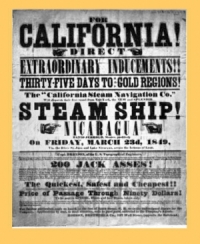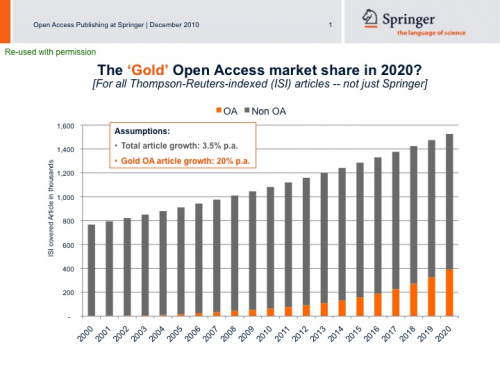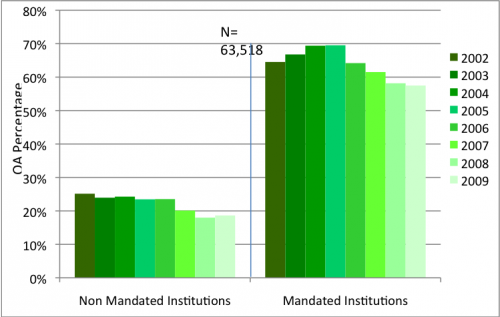Friday, June 10. 2011
 Jan Szczepanski Jan Szczepanski [ JSZCZ] wrote in the American Scientist Open Access Forum: JSZCZ: After collecting free e-journals for more than ten years I'm amazed to read a phrase like this one produced by Steven Harnad.SH: "But gold OA is still premature (whether for journals or books)." I have concentraded on journals in humanities and social sciences and have more than 12.000 for the moment.
In DOAJ, the directory of open access journals, there are 6.590 titles.
In EZB, Elektronische Zeitschriftenbibliothek, there are more than 32.000 titles.
An astonishing development during these years made by scientists and scholars for scientists for scholars.
The reality is that Steven Harnads opinion is all wrong about journals and also about free e-books. Millions of books are free for all.
This is what I would describe as real open access. Real articles and books. All OA content -- whether green or gold -- is welcome, valuable and important. That is not the issue. The issue is how to increase OA content.
To get a realistic idea of how much OA content there is, how fast it is growing, and what scope there is for accelerating its growth, it is not enough simply to count Gold OA items. You have to calculate the annual proportion of Gold OA items, as well as their growth rate, and you have to compare them with the annual proportion and growth rate of Green OA items.
The underlying question is: Which is the surest and fastest way to reach 100% OA, now? And the answer is: by mandating Green OA, not by waiting for Gold OA:
(a) The total annual percentage of journal articles that are OA today averages somewhere between 20% and 30%, and it varies by field.
(b) Out of the overall annual 20-30% OA, according to the 2010 estimates of Bo-Christer Björk for 2009, in the Thompson-Reuters-ISI-indexed journals the proportion of Green OA was 2/3 and the proportion of Gold OA was 1/3. In non-ISI-indexed journals the relative proportions of the OA subset were reversed (2/3 Gold, 1/3 Green).
(According to Ulrich's there are about 25,000 peer-reviewed journals across all disciplines today. ISI indexes about the top 20% of them, and about 7% of those 10,000 ISI-indexed journals [but mostly not the top ISI journals] are Gold OA: one wonders what proportion of the 32,000 EZB Gold OA journals -- or of Jan Szczepanski's 12,000 Gold OA humanities and social science journals -- are peer-reviewed journals.)
(c) Out of the overall annual 20-30% OA, according to the 2010 estimates of Bo-Christer Bjork for 2009, in all disciplines except the biomedical ones, the proportion of Green OA was much higher than the proportion of Gold OA. In the biomedical disciplines the relative proportions were reversed. The overall percentage of OA was lowest in the biomedical disciplines. Björk B-C, Welling P, Laakso M, Majlender P, Hedlund T, et al. (2010) Open Access to the Scientific Journal Literature: Situation 2009. PLOS ONE 5(6): e11273. (d) In 2010 Springer publishers estimated that for ISI-indexed journals, growth is 3.5% annually and gold OA growth is 20% (of current Gold OA) annually, so in 10 years the overall percentage of Gold OA will have increased from 8% Gold OA out of all (ISI) articles published in 2010 to 27% Gold OA out of all (ISI) articles published in 2020:  Figure 1. Projections of Gold OA Growth for ISI-indexed journal articles (data from Springer publishers). Growth will reach 27% of all journal articles by 2020. Figure 1. Projections of Gold OA Growth for ISI-indexed journal articles (data from Springer publishers). Growth will reach 27% of all journal articles by 2020.
(e) In contrast to the overall annual percentage of OA (20-30%) and Gold OA's growth rate that will take us from its current 8% to 27& in 2020, institutions that mandate Green OA provide over 60% OA, and and keep climbing toward 100% within a few years. 
Figure 2. Percent green OA self-archiving averaged for the four institutions with the oldest self-archiving mandates, compared to the percentage for control articles from other institutions published in the same journals (for years 2002-2009, measured in 2011). Mandates triple the percent Green OA. Respective totals are derived from Thompson-Reuters-ISI index.
Gargouri, Y., Hajjem, C., Lariviere, V., Gingras, Y., Brody, T., Carr, L. and Harnad, S. (2010) Self-Selected or Mandated, Open Access Increases Citation Impact for Higher Quality Research PLOS ONE 5 (10)
Hence there are three reasons Gold OA is premature, and (e), above, immediately reveals the first and most important of them:
1. Green OA Can Be Accelerated By Mandating It: Green OA depends only on the research providers -- institutions and funders -- and can hence be accelerated to 100% by mandating it. Gold OA depends upon publishers; institutions and funders cannot mandate it, hence cannot accelerate its growth. (However, mandating Green OA is also likely to accelerate the eventual transition to Gold OA; but first it will provide OA -- 100% OA -- and OA is the primary target and hence the priority of the OA movement.)
2. The Economic Benefits of Green OA Are Greater And More Immediate Than Those of Gold OA: Houghton et al have shown that there are considerable economic benefits to be expected from both Green and Gold OA, but the benefit/cost ratio of Green OA is much higher. Harnad, S. (2010a) The Immediate Practical Implication of the Houghton Report: Provide Green Open Access Now. Prometheus 28 (1). pp. 55-59.
Houghton, J.W., Rasmussen, B., Sheehan, P.J., Oppenheim, C., Morris, A., Creaser, C., Greenwood, H., Summers, M. and Gourlay, A. (2009). Economic Implications of Alternative Scholarly Publishing Models: Exploring the Costs and Benefits, London and Bristol: The Joint Information Systems Committee (JISC) 3. The Money to Pay for Gold OA Is Still Tied Up In Institutional Journal Subscriptions and the Asking Price For Gold OA Is Still High: The vast majority of journals (and almost all the top journals) are still subscription-based. That means that the potential institutional funds to pay for Gold OA are still tied up in institutional subscriptions, which institutions cannot cancel unless the contents of the journals are accessible to their users by another means. That other means is Green OA -- once it is universally mandated. This is also how Green OA mandates can accelerate the transition to Gold OA. And it is the third reason Gold OA is premature. When distributed Green OA institutional repositories take over the entire function of text-generation, access-provision, and archiving, journals will be able to cut costs by terminating their paper and online editions and providing only the service of peer review, certifying the outcome with the journal name. That means the post-Green-OA cost of Gold OA will then be much lower. Harnad, S. (2007) The Green Road to Open Access: A Leveraged Transition. In: Anna Gacs. The Culture of Periodicals from the Perspective of the Electronic Age. L'Harmattan. 99-106.
Harnad, S. (2009) The PostGutenberg Open Access Journal. In: Cope, B. & Phillips, A (Eds.) The Future of the Academic Journal. Chandos. About Gold OA books I have little to say, except that their proportion (out of all book, or even out of all scholarly/scientific books) is minuscule, cannot be accelerated by mandates, and involves a conflict of interest for royalty-seeking authors -- whereas for journal article authors it does not. Rather the opposite: journal article authors are losing potential usage and impact if only users at subscribing institutions can access their articles.
That -- not absolute Gold OA item counts -- is the reality today.
Stevan Harnad
Enabling Open Scholarship
http://www.openscholarship.org
Saturday, June 4. 2011
  There is a blatant contradiction between two statements of Institute of Physics ( IOP) Publishers policy on Green OA self-archiving of the author's refereed final draft. It is not clear whether IOP is on the side of the angels or...:
A. There is this one, according to which IOP is and remains on the side of the angels: ...Exercise of the rights in 3.3 additionally must not use the final published IOP format but the Named Author’s own format (which may include amendments made following peer review).
….3.3.2 Include the Article (all or part) on a Named Author’s own personal web site;
3.3.3 Include the Article (all or part) on web sites of the Institution (including its repository) where a Named Author worked when research for the Article was carried out; and
3.3.4 Include the Article (all or part) on third party web sites including e-print servers, but not on other publisher’s web sites. G. Then there is this one (amidst a lot of puffery about Gold OA publication), according to which "IOPScience" is on the other side: What is IOP's policy on self-archiving?
IOP also supports authors who are required by their funding agencies to make their research papers freely available via an institutional or subject repository. Authors may post their accepted manuscript in an institutional or subject repository after an embargo period of 12-24 months following publication, depending on the journal. Question for the Managing Director of IOP Publishing (Steven Hall): Which is it? Angels or...? And if this is a difference between IOP policy and " IOPScience" policy, it would be very helpful to have a clear explanation of which is which, and which journals are involved in each.
Addendum
I may be mistaken, but I think IOP may be conflating IOP journal embargo policies and IOP repository embargo policies.
According to IOP's current online documentation (not only the current IOP general copyright form, but also the current IOP copyright FAQs - see below), IOP authors may immediately deposit the author's final draft in their institutional repository (or a central repository, like Arxiv). No embargo. No fee: IOP | For Authors Frequently Asked Questions (FAQ)
e-print servers 12. I have submitted my article to an IOP journal. Can I also submit it to
arXiv.org or any other repository as well?Yes, articles may be posted on non-commercial third party websites, including arXiv and other repositories. The author’s own original format should be used (which may include amendments made by the author following peer review). This is the version commonly known as the accepted manuscript. If possible, citation information should be included with IOP’s copyright notice. Once the final version has been published, best efforts must also be made to include a link to the online abstract of the paper in the journal. Authors MUST NOT deposit the published IOP formatted version. IOP also requests that you include the following statement of provenance: 'This is an author-created, un-copyedited version of an article accepted for publication in [insert name of journal]. IOP Publishing Ltd is not responsible for any errors or omissions in this version of the manuscript or any version derived from it. The definitive publisher authenticated version is available online at [insert DOI].'
When submitting an article to arXiv you have to select a licence or declaration which gives the arXiv the rights necessary to distribute your article. IOP is happy for you to select the first option offered, namely 'arXiv.org perpetual, non-exclusive licence to distribute your article'. Please do not accept any of the other options without consulting with IOP in advance at permissions@iop.org.
See also Question 17 below.
Author’s rights after publication by IOP
17. May I post my paper on my personal website or my institutional website?
Yes, IOP authors can place their papers (all or part) on their own personal website, but they must not use the IOP formatted version of record (PDF or HTML). Instead they can make use of the article in their own format, which can include amendments made following peer review. This is the version commonly known as the accepted manuscript. The purpose of the posting must be non-commercial, if possible should display citation information and IOP’s copyright notice. Once the final version has been published, best efforts must be made to include a link back to the online abstract in the journal. Authors MUST NOT post the published IOP formatted version. IOP also requests that you include the following statement of provenance: 'This is an author-created, un-copyedited version of an article accepted for publication in [insert name of journal]. IOP Publishing Ltd is not responsible for any errors or omissions in this version of the manuscript or any version derived from it. The definitive publisher authenticated version is available online at [insert DOI].'
IOP authors may also place their papers on the website of the institution (including its repository) where a named author worked when research for the article was carried out, however there is an embargo period that can vary between journals so please refer to the individual journal copyright forms. Typical embargo periods range from 12-24 months.
For posting on e-print servers see Question 12 above.
There is no mention at all made of exceptions -- by journal. However, there is a mention of an exception by repository: For some (unspecified) reason, IOP authors may not deposit their final drafts in NIH's PubMed Central:
13. What is IOP’s policy with regard to UK PubMed Central and NIH?
On or after acceptance for publication IOP authors may deposit their articles in PubMed/NIH provided the articles are embargoed for public release for 12 months from the official date of publication and further provided the deposited version is in the author’s own original format (which may include amendments made by the author following peer review). This is the version commonly known as the accepted manuscript. Authors MUST NOT deposit the published IOP formatted version. IOP also requests that you include the following statement of provenance: 'This is an author-created, un-copyedited version of an article accepted for publication in [insert name of journal]. IOP Publishing Ltd is not responsible for any errors or omissions in this version of the manuscript or any version derived from it. The definitive publisher authenticated version is available online at [insert DOI].'
IOP is currently considering introducing a service to deposit articles at UK PubMed Central and NIH for authors in the future. Now this exception (though a rather arbitrary one) would still leave IOP on the side of the angels. Could someone from IOP please confirm whether this continues to be the only exception (apart from rival publishers' 3rd-party repositories, of course)? That would serve to correct the apparent contradiction with the following June 2011 update: IOP Publishing open access policy What is IOP's policy on self-archiving?
IOP also supports authors who are required by their funding agencies to make their research papers freely available via an institutional or subject repository. Authors may post their accepted manuscript in an institutional or subject repository after an embargo period of 12-24 months following publication, depending on the journal.
Publishing a gold OA journal (New Journal of Physics, NJP), as IOP does, is admirable, but if I am not mistaken, IOP publishes 29 journals -- plus 38 more in partnership with other learned societies. I will assume (conservatively) that the IOP FAQ speaks only for the 29 journals published by IOP (although IOP's one pure open access journal, NJP, is one of the partnered journals). Open access means open access to all the articles in all the 29 IOP journal, not just the articles in NJP. Not that being "on the side of the angels" means that all 29 IOP journals need to be gold OA journals: it just means that all 29 IOP journals endorse author self-archiving of the final draft, immediately upon acceptance for publication (green OA). That is what the current IOP copyright agreement states clearly in clause 3.3.2 and 3.3.3 and the current IOP copyright FAQ states clearly in clause 12 and 17.
Being "on the side of the angels" has become a metaphor in the OA world for endorsing immediate green OA self-archiving of the author's final draft, as IOP had done since at least 2006. Regarding the sustainability of the subscription model, Alma Swan reported in 2005 that IOP and APS, the publishers with the longest experience with green OA self archiving, dating all the way back to 1991, and having long ago reached 100% in several fields, responded as follows: "In a separate exercise we asked the American Physical Society (APS) and the Institute of Physics Publishing Ltd (IOPP) what their experiences have been over the 14 years that arXiv has been in existence. How many subscriptions have been lost as a result of arXiv? Both societies said they could not identify any losses of subscriptions for this reason and that they do not view arXiv as a threat to their business (rather the opposite --in fact the APS helped establish an arXiv mirror site at the Brookhaven National Laboratory)."
CODA
Now it would look unprepossessing in the extreme, would it not, if a publisher were to air the following policy today: "We are progressive publishers, not trying to oppose OA: You may make your final draft green OA by depositing it in your institutional repository -- except if you are mandated to do so (by your funder or institution), and especially if your funder or institution is foolish enough to offer to pay for gold OA. In that case, you may only deposit it if you pay; or must wait 12 or 24 months if you don't -- even if you've already been providing immediate green OA for free for 'lo these 20 past years already..."
|

 Figure 1. Projections of Gold OA Growth for ISI-indexed journal articles (data from Springer publishers). Growth will reach 27% of all journal articles by 2020.
Figure 1. Projections of Gold OA Growth for ISI-indexed journal articles (data from Springer publishers). Growth will reach 27% of all journal articles by 2020.


